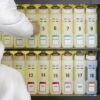In gathering more information to answer this question, my first questions would be:
- Are you using 10% neutral buffered formalin (NBF)?
- Is the first alcohol after the NBF 95% alcohol?
I’m going to assume your answers would be YES to both of these questions.
Let’s review tissue processing for a moment, so we’re all on the same page. Tissue is received in the grossing room, cut into smaller pieces, placed in cassettes, and then placed in a fixative (in this case NBF) until placed on the tissue processor. Usually there is an extra one or two containers of NBF on the processor, to allow more fixation time during processing.
The next processing steps involve using multiple changes of alcohol to remove the unbound water from the tissue. This allows the subsequent steps of xylene and paraffin to penetrate the tissue, something they cannot do if there is water in the tissue. Often, the alcohols on the tissue processor are progressed up through higher percentages of alcohol, for example, 70% (1 change), 95% (1-2 changes), 100% (2-3 changes). By starting in a lower percentage of alcohol, and then slowing increasing the percentage of alcohol, this allows for a more gentle removal of water from the tissue, and a more gentler introduction of alcohol into the tissue, as compared to going from NBF directly to 100% alcohol.
What’s in 10% Neutral Buffered Formalin? About 90% water and 10% full strength (4%) formaldehyde (which makes 10% formalin) plus buffering salts. If the 10% formalin is unbuffered, the pH of the unbuffered formalin would be about 5.0-5.7, due to the presence of formic acid. At this acidic pH, tissue proteins and nuclei could be destroyed, and formalin pigments would form over the tissue. To prevent this, buffering salts are added to the diluted formalin to neutralize the acidity, and bring the pH to around 7.2-7.4, which will also prevent formalin pigments. Most neutral buffered formalin use a combination of two salts, sodium phosphate monobasic and sodium phosphate dibasic (or sodium hydroxide), though some modifications use either calcium carbonate or calcium acetate to neutralize the formalin.
These salts are very soluble in water, but do not dissolve in alcohol, and will precipitate out. This is the most likely cause of your problem. The salts are miscible in the 10% NBF and in your tissues, because you NBF is 90% water, and the tissue cells are 70% water. If the next step on the tissue processor is 95% alcohol, then there is only 5% water. The NBF that is carried over on the tissue and the cassettes, and the NBF that is being pulled out of the tissue, still contain the buffering/neutralizing salts. There is not enough water in 95% alcohol, for them to dissolve into, so the salts will precipitate out in the alcohol.
Solution to the problem: I can think of three:
If there is a space for an extra container:
1) Slip in a container of 70% alcohol between the second NBF and the first 95% alcohol.
If there is not space for an extra container:
2) If there are two 95% alcohols on the processor, change the first one to 70% alcohol. This contains 30% water, which will be a high enough percentage of water to allow the buffering salts to dissolve. The 70% alcohol will still begin the dehydrating process, and in fact, will be gentler on the cells than if going from NBF directly to 95% alcohol. OR
3) If there are two NBF on the processor, change the second one to alcoholic formalin. This is made up of 60-70% of full strength (100%) alcohol, 20-30% water, and 10% full strength (4%) formaldehyde. There is enough water to dissolve out the buffering salts, there is enough formalin (10%) to continue with fixation, and there is a high enough percentage of alcohol (60-70%) to begin the dehydration step.
I hope this takes care of your problem.
References:
- Suvarna SK, Layton C, Bancroft JD: Bancroft’s Theory and Practice of Histological Techniques, 7th ed. Churchill Livingstone, 2013
- Carson FL, Hladik C : Histotechnology: A Self-Instructional Text, 3rd ed. ASCP Press, 2009.
- Kiernan JA: Histological and Histochemical Methods: Theory and Practice, 3rd ed. Butterworth Heinemann, 1999


